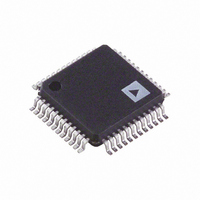AD9952YSVZ Analog Devices Inc, AD9952YSVZ Datasheet - Page 22

AD9952YSVZ
Manufacturer Part Number
AD9952YSVZ
Description
IC DDS 14BIT DAC 1.8V 48-TQFP
Manufacturer
Analog Devices Inc
Datasheet
1.AD9952YSVZ.pdf
(28 pages)
Specifications of AD9952YSVZ
Resolution (bits)
14 b
Master Fclk
400MHz
Tuning Word Width (bits)
32 b
Voltage - Supply
1.71 V ~ 1.96 V
Operating Temperature
-40°C ~ 105°C
Mounting Type
Surface Mount
Package / Case
48-TQFP Exposed Pad, 48-eTQFP, 48-HTQFP, 48-VQFP
Pll Type
Frequency Synthesis
Frequency
400MHz
Supply Voltage Range
1.71V To 1.89V
Digital Ic Case Style
TQFP
No. Of Pins
48
Operating Temperature Range
-40°C To +105°C
Msl
MSL 3 - 168 Hours
Lead Free Status / RoHS Status
Lead free / RoHS Compliant
For Use With
AD9952/PCB - BOARD EVAL FOR AD9952
Lead Free Status / RoHS Status
Lead free / RoHS Compliant, Lead free / RoHS Compliant
Available stocks
Company
Part Number
Manufacturer
Quantity
Price
Company:
Part Number:
AD9952YSVZ
Manufacturer:
TI
Quantity:
449
Company:
Part Number:
AD9952YSVZ
Manufacturer:
ADI
Quantity:
700
Company:
Part Number:
AD9952YSVZ
Manufacturer:
Analog Devices Inc
Quantity:
10 000
Part Number:
AD9952YSVZ
Manufacturer:
ADI/亚德诺
Quantity:
20 000
Company:
Part Number:
AD9952YSVZ-REEL7
Manufacturer:
Analog Devices Inc
Quantity:
10 000
AD9952
Serial Interface Port Pin Description
SCLK—Serial Clock. The serial clock pin is used to synchronize
data to and from the AD9952 and to run the internal state
machines. SCLK maximum frequency is 25 MHz.
CS —Chip Select Bar. CS is active low input that allows more
than one device on the same serial communication line. The
SDO pin and SDIO pin go to a high impedance state when this
input is high. If driven high during any communication cycle,
the cycle is suspended until CS is reactivated low. Chip select
can be tied low in systems that maintain control of SCLK.
When toggling CS , it is important that care is taken to meet the
clock setup time with respect to the falling edge of CS and TCSU
(see Figure 27).
SDIO—Serial Data I/O. Data is always written into the AD9952
on this pin. However, this pin can be used as a bidirectional
data line. Bit 9 of Register 0x00 controls the configuration of
this pin. The default is Logic 0, which configures the SDIO pin
as bidirectional. In order to guarantee proper serial I/O port
operation (see Figure 27), data on this pin must be set up and held
to the rising edge of SCLK on read operations.
SDO—Serial Data Out. Data is read from this pin for protocols
that use separate lines for transmitting and receiving data. In
the case where the AD9952 operates in a single bidirectional
I/O mode, this pin does not output data and is set to a high
impedance state.
IOSYNC—Synchronizes the I/O port state machines without
affecting the registers’ contents. An active high input on the
IOSYNC pin causes the current communication cycle to abort.
After IOSYNC returns low (Logic 0), another communication
cycle can begin, starting with the instruction byte write.
I/O BUFFERS
REGISTERS
I/O UPDATE
SYNC_CLK
SYSCLK
DATA IN
DATA IN
DATA 1
THE DEVICE REGISTERS AN I/O UPDATE AT POINT A. THE DATA IS TRANSFERRED FROM THE I/O BUFFERS AT POINT B.
DATA 0
A
Figure 26. Timing of I/O Update Signal vs. Actual Register Update
B
DATA 2
Rev. B | Page 22 of 28
SCLK
MSB/LSB Transfers
The AD9952 serial port can support both most significant bit
(MSB) first or least significant bit (LSB) first data formats. The
control register, Register 0x00, Bit 8, controls this functionality.
The default value of Register 0x00 [8] is low (MSB first).
When the control register (0x00 [8]) is set high, the AD9952
serial port is in LSB-first format. The instruction byte must be
written in the format indicated by the control register (0x00
[8]), and the instruction byte must be written from least
significant bit to most significant bit (right to left in the table
located in the Instruction Byte Details section).
Note that even in LSB-first mode, the two respective phases of
the communication cycle, the instruction byte phase and the
data communication phase, retain their respective positions.
DATA 1
SDIO
CS
Figure 27. Serial Port I/O Setup (TCSU, TDSU) and Hold (TDH) Times
Figure 28. Serial Port I/O Data Valid Time (TDV) During Readback
SCLK
SDIO
SDO
TCSU
DVDD I/O = 3.3V
TCSU = 3ns
TDSU = 3ns
TDH = 0ns
A
TDSU
DATA 3
TDV = 25ns
DVDD I/O = 1.8V
TDH
TCSU = 5ns
TDSU = 5ns
TDH = 0ns
B
DATA 2
● ● ●
● ● ●
● ● ●
TDH












